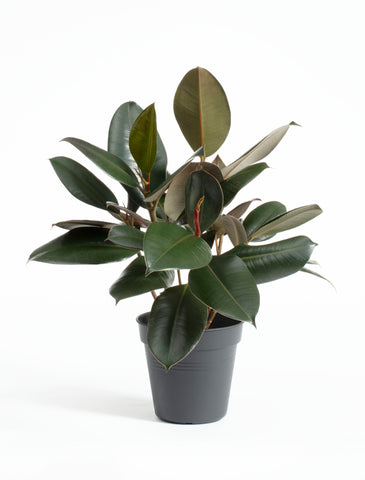Rubber Plant
Varieties
Ficus Elastica ‘Burgundy’ / ‘Tineke’ / ‘Ruby Red’
Origin
Native to North Eastern India and surrounding regions
Air purifying
Toxic to pets/people
General Care
Light
Medium to bright filtered. Tolerates small doses of direct sun. Tolerates low light; rich burgundy leaf colour or variegation may fade in these circumstances
Temperature
18-24°C. Keep above 10°C. Protect from sudden temperature drops and hot or cold drafts.
Humidity
Average.
Water
Weekly. Water moderately (year round) and allow thoroughly moist potting mix to dry within top 2-3”. Avoid water on leaves, which may cause stains. Sensitive to overwatering and susceptible to root rot. Always check moisture level before watering. Aerate mix to improve its condition.
Fertilizer
Every 2 weeks at half-strength (spring-fall). Use organic houseplant fertilizer, and according to packaging instructions.
Maintenance
Every 1-2 weeks, rotate plant to ensure even growth. Every 1-2 months, dust leaves and remove leaf stains using a mild mixture (1 tsp dish detergent OR 1 tsp vinegar and 1 L water). Rinse with water. Inspect for pests, when doing so. Remove spent leaves. Prune annually (spring) with sterile shears. Cut back to just above leaf node, as far down stem as desired. Apply paper towel to stanch sap flow from wounds; let dry overnight. Avoid mildly toxic sap and immediately wash exposed skin or hands with warm water and soap.
Potting and Repotting
Soil-based potting mix. For small plants: every 1-2 years (spring) move plant into a planter 1-2” larger (diameter and depth); or, repot in the same planter, using new potting mix, after cleaning planter and partially trimming back roots and foliage. For large plants: every 2-3 years (spring) move plant into a planter 2-4” larger (diameter and depth); or, repot in the same planter, using new potting mix, after cleaning planter and partially trimming back roots and foliage. Top dress annually, once maximum convenient planter size reached.
Special Points/Common Problems:
- Red sheaths protect new, emerging growth.
- Brown tips with yellow edging and leaf drop from plant base may suggest overwatering.
- Droopy or fully yellow leaves and crispy brown tips without yellow edging may suggest underwatering.
- Isolated, brown spots, tears or cracks on an otherwise healthy leaf and plant may suggest damage from physical trauma.
- May drop leaves when transplanted , moved or subject to environmental changes in light or temperature.
